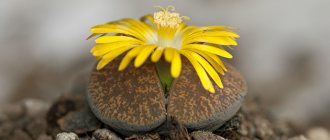Encyclopedia of Succulents
Succulents were previously considered something incomprehensible and not the most attractive in home decoration. But time passes, views change, and now these plants are popular crops among many gardeners. There is a huge variety of such representatives, but this article will discuss the succulent Portulacaria afra, its features and rules for caring for the crop.
- 1 Description of the plant Portulacaria Africana
- 2 How to grow the succulent Portulacaria africanica at home 2.1 Lighting
- 2.2 Watering
- 2.3 Fertilizer
Portulacaria species
The genus includes five plant species, including: African portulacaria - in its homeland it grows up to 3 m, thick light green leaves. The trunk is covered with wrinkled dark brown bark, smooth. Rarely blooms indoors;
- Portulacaria African form is variegated - shorter in height, green leaves with white stripes along the edges. Lack of lighting affects the variegation: it disappears. If the lighting is good, variegated portulacaria becomes compact: the leaves are small with a pink stripe along the edge, the trunk is dark;
- Portulacaria African form variegated cultivar - small size, small leaves, variegation in the middle of the leaf blade. Insufficient lighting causes the disappearance of variegation; in good lighting, the plant is compact, the leaves are small with a pinkish tint, and the trunk is red.
Varieties
To expand the field of activity for gardeners, botanists artificially bred the following varieties of succulents:
- Portulacaria variegata. The plant is recognizable by its oblong leaves of variegated color. A bright light green stripe is visible in the center, and the edges are “filled” with a silver tone. From the core to the edges there are many thin, barely noticeable strokes, located perpendicular to each other. The height of the bush does not exceed 1 m.
- Portulacaria variegata tricolor. To the green and whitish color of the leaves, a pink-lilac tint is also added. The edges of the foliage and adjacent stems are “flooded” with it. The height and shape of the crown of the plant is similar to the previous variety.
Portulacaria variegata tricolor
Portulacaria variegata
Features of care
Portulacaria is unpretentious in care; even beginning gardeners can grow it. The plant requires a minimum of conditions for comfortable growth.
In order for portulacaria to develop normally, it needs bright lighting, including direct sunlight.
The plant should be placed on windows facing south. It is recommended to periodically rotate the plant to keep the crown looking beautiful.
In winter, portulacaria needs additional lighting. The temperature that is usually maintained in apartments is quite suitable for growing portulacaria.
In summer, it is recommended to take the plant out into the air (into the garden or onto the balcony), since portulacaria requires ventilation and fresh air.
In winter, it is advisable to create cool conditions for the plant, but the temperature should not fall below 10 degrees (at lower temperatures the leaves may freeze). Portulacaria does not require high humidity, although it is recommended to wash off dust from the leaves with a warm shower.
When planting portulacaria, you should take into account that it needs low-fertility, slightly acidic or neutral soil with a slight addition of sand. You can prepare your own soil mixture for portulacaria from 2 parts garden soil, 3 parts coarse sand, 2 parts humus, 1 part charcoal, a small amount of lime.
You can mix leaf and turf soil in equal parts and add sand. The plant requires good drainage (from coarse sand, perlite, brick chips or other loosening materials).
It is recommended to replant portulacaria once every two years.
Light
If you have an indoor garden, be sure to place the bush near a south-facing window. If this is not possible, western and eastern exposures will do. The photo of portulacaria shows leaves in direct sunlight that have red or yellow tips.
So, if you want to keep your plants green, avoid excessive sunlight. Finding the perfect location for Portulacaria may take some time, but it is worth it.
Watering portulacaria
In summer, you should water it in such a way that the top layer has time to dry out between waterings. In November and February, watering once a month is recommended; do not water in winter - December - January. Since portulacaria is a succulent, it tolerates drought well and can easily withstand lack of watering.
It is unacceptable to leave water in the pan. To find out whether a plant needs watering, just look at the leaves: they may be wrinkled, but after watering they become smooth.
Origin and botanical description of the plant
African portulacaria (portulacaria afra) came to us from the arid deserts of Africa. This exotic plant is unique for bonsai enthusiasts because it is the only succulent suitable for this art.
Portulacaria belongs to the Portulacaceae family; there is only one plant species in its genus. It is a succulent evergreen perennial. The rhizome of portulacaria is quite powerful, it is capable of feeding it even in extreme conditions. Above the ground are branched, fleshy shoots covered with dense, smooth bark.
Afra leaves are bright green and quite fleshy if the plant is healthy and properly watered. Due to this, portulacaria bonsai creates the effect of freshness and vigor. The leaves, despite their structure, are slightly translucent, so the plant looks good on window sills.
Unlike many other succulents, the plant has a distinct tree-like trunk, distinguished by very beautiful bark. When properly lit, it seems to glow, and the pleasant pale brown shade fits well into any light interior.
Leaves are located only on young branches. Petiolate, round or oblong foliage has smooth edges. The length of the leaves is 2-3 cm, and the width is 1-2 cm. The leaves are thickened and covered with a dense, waxy skin of bright green color.
Flowering occurs in February-April. Axillary, spike-shaped inflorescences appear on young branches. They consist of many white and pink five-petaled flowers that resemble small stars. The diameter of the flower is 2.5 cm, and the length of the entire inflorescence does not exceed 7-8 cm. In place of the flowers, juicy berries with pink skin later ripen.
Reproduction
Three methods are used: seeds, layering, stem cuttings.
Take stem cuttings cut in April or May. You should take thick branches with at least four pairs of leaves. The length of the cutting should be about 15 cm, the cut is made obliquely.
the cuttings for a week, then remove the leaves located on the lower part of the cutting.
After 10 days, wrinkled tissue and white spots appear near the cut - this indicates that the process of root formation has begun. To root cuttings, use plastic cups with a mixture of sand and peat (water first and let dry).
Rooting requires diffused light and temperatures up to 25 degrees. The rooting process lasts about three weeks. After two months, the plant should be transplanted to a permanent place.
When propagating by seeds, a difficulty arises: within several months their viability is lost. The seeds are sown in a mixture of damp sand and peat, slightly moistened and covered with glass or plastic film.
It is necessary to maintain the temperature to 28 degrees (not lower than 24 degrees) and periodically moisten. After emergence, diffused light is required.
When propagating by layering, the branch should be bent to the soil, and after the formation of roots, this branch should be separated from the mother plant.
Transfer
If you begin to notice the size of the roots getting out of control and growing out of the drainage holes, move the plant to a larger container.
You will notice that portulacaria flowers appear quickly when the leaves or branches are cut, so its formation and propagation is a fun and easy process.
The Portulacaria succulent is quite amazing and there are many benefits to growing it. If you find the perfect spot for it in your indoor or outdoor garden, this versatile succulent will grow quickly with minimal effort on your part.
Top dressing
Portulacaria requires feeding during the period when active vegetation is in progress. It must be done twice a month. A fertilizer with a low nitrogen content is recommended (you can use a fertilizer specifically designed for cacti).
In winter , portulacaria should not be fed if it is in a cool room. If portulacaria remains in a warm room for the winter, it is recommended to fertilize it once a month.
Read about caring for nephrolepis at home in this article.
Brugmansia can be grown from seeds. Find out more about this, as well as the rules for planting and caring for the plant.
Amorphophallus is an unusual flower, https://sad-doma.net/houseplants/decorative-leaf/neobychnyj-amorfofallus.html which can be grown at home.
Variegate tricolor
It differs from the previous variety in the presence of pink shades. The leaves have a whitish center and greenish dark edges. The branches and edging of the foliage are bright pink. With proper care, the succulent has a beautiful red trunk and pinkish leaves. Look at the photo below to see what the variety Portulacaria Vareigata tricolor looks like:
Variegate tricolor
Problems when growing portulacaria
Insufficient light in winter can cause the plant to shed its leaves, but they recover in the spring. Insufficient lighting causes the shoots to become very elongated.
The same thing happens with excessive watering or fertilizing; pruning of portulacaria is required. The plant constantly needs fresh air; it does not tolerate stagnation. Overwatering can cause root rot.
And for the curious, we suggest you watch the video about portulacaria
Crown formation
Crown trimming can be done in any way, focusing on your own aesthetic preferences. Even if the pruning is too strong and not of very high quality, the plant has the ability to quickly recover and grow foliage. This work is usually carried out in the spring during the period of active growth of stems.
In addition to pruning, portulacaria requires regular pinching of young shoots. As a result, the plant does not “grow” in height, but acquires a beautiful spreading crown. Restraining the growth of a flower by shortening the tops is also due to the impossibility of tying it to a wire. Supporting the branches in this way is too traumatic for the tender, fleshy leaves, so when creating the shape it is best to use the pruning method.
Possible difficulties
If Portulacaria drops its leaves, there may be several reasons for this. In the summer months, the plant can simply get rid of its outdated lower leaves. If young leaves wither and fall off, it means that watering standards have been exceeded and the plant may need to be treated for root rot (Recommendations are provided on the website in the “Diseases and Pests” section). Winter leaf fall is evidence of warm conditions.
The loss of decorative appearance (elongated shoots, elongated internodes) is caused by insufficient lighting, excessive watering and fertilizing with a high nitrogen content.
It is recommended to prune and subsequently adjust the care parameters. Editorial team LePlants.ru
First steps after purchase
When purchasing Portalucaria, you need to carefully examine the plant. Blackening of the lower part of the stem is a sign of root rot. In this case, it is better to refuse the purchase.
A new copy of the flower collection should be quarantined. Portulacaria is often attacked by scale insects, which cannot always be detected upon first inspection. Recommendations for combating dangerous insects are presented on the website in the “Diseases and Pests” section.
If the plant is transplanted into a new container, watering is canceled for the period of adaptation (2 weeks).
When purchasing seeds, you need to pay attention to the packaging date. They lose their germination very quickly. Sow planting material in a container filled with peat and perlite. Then they are covered with polyethylene and grown at a temperature of +25–28°C. The mini-greenhouse is placed in a sunny place and bottom watering is carried out periodically.
Recommended by topic
Ficus sacred Saintpaulia Zephyranthes Since portulacaria is a succulent that grows in arid climates,
it can easily tolerate moisture deficiency. Moreover, you need to avoid frequent watering, and moisten the soil only after 1/3 of it has dried out. In the case of a cold winter, it is better to reduce the intensity of watering, since if there is an excess of moisture, the root system and leaves will begin to rot. If watering is insufficient, the foliage shrinks and loses its decorative effect. But after resuming the procedure, the leaves again acquire an attractive appearance. For irrigation , water at room temperature that does not contain chlorine is used. If the tap liquid is not chlorinated, you can take it straight from the tap without settling.
The hardness index is not particularly important. No artificial increase in humidity is required. But for hygienic purposes, it is recommended to periodically give the plant a warm shower to remove accumulated dust.
Top dressing
At the stage of intensive growth and development, you can feed the succulent once every 2 weeks. Preparations with low nitrogen concentrations are suitable for these purposes.
So, you can purchase ready-made fertilizer for succulents and cacti in liquid form. From mid-autumn to mid-spring, fertilization should be stopped.
Transfer
Portulacaria does not have a particular growth rate, so frequent transplants are only necessary for young specimens.
An adult flower can be replanted only after discovering that there is not enough space in the pot for the root system. A young plant is replanted every 2-3 years along with a scheduled soil change. As for adult specimens, this can be done every 5-6 years.
Otherwise, the succulent will begin to feel the lack of space, and its root system will be seriously damaged. This will lead to the development of various diseases.
During transplantation work, you should use a container with a diameter 2-3 cm larger than the previous one. Sometimes you can limit yourself to trimming the roots and changing the soil while maintaining the previous container.
The pot should be heavy with a massive bottom so that the plant does not tip over when growing towards the light source.
Priming
The substrate for growing portulacaria should have a low concentration of nutritional components and be loose. It must also allow air and water to pass through.
To prepare the soil mixture, you should combine:
Purchased substrate for cacti and succulents.
Coarse sand (vermiculite can be used as an alternative).
Brick chips (or fine gravel).
The ratio of components is 3:1:1.
All ingredients must be purchased from a specialized flower shop and kept in the oven for 1.5 hours before mixing.
Small stones or brick chips can be used as drainage materials.
Trimming
When grown indoors, portulacaria needs to be pruned. This procedure is used to form the crown and implement non-standard design ideas. In addition, timely pruning stops the growth of the flower.
It is recommended to cut young shoots in the spring. After this, the intensity of watering should be reduced, as soil rotting may occur.
For several days after pruning, there is no need to water the portulacaria, but replace the procedure by spraying with clean water from a spray bottle.











